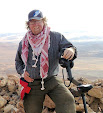Several pieces of explosively fractured rail from the Hijaz line were found today by a small team working on new tent rings in the flat plain between the upper region of Tel el Shahm and the station on that line. We know that there was an attack by Lawrence and Arab forces on this station and these fragments are almost certainly remnants of this. We also know that several large bombs were dropped at this site, and indeed fragments of such dating exactly from the time were found as well.
 In and around the tent rings in this new region an array of metal finds confirmed that Ottoman forces occupied this camp, and the nature of these can be seen in the pictures below. Buttons of the Ottoman Imperial Guard, general uniform buttons, coins and pieces of metal associated with the routine of life in the army such as padlock fragments and lamp wick holders all provide this evidence strongly. This is the first day that significant metal finds have occurred, and this region of the extended site clearly has a different finds concentration from this period than the other region closer to the hilltop and to the North of the rocky outcrop. Theories as to why this is so are being bandied about as I write!
In and around the tent rings in this new region an array of metal finds confirmed that Ottoman forces occupied this camp, and the nature of these can be seen in the pictures below. Buttons of the Ottoman Imperial Guard, general uniform buttons, coins and pieces of metal associated with the routine of life in the army such as padlock fragments and lamp wick holders all provide this evidence strongly. This is the first day that significant metal finds have occurred, and this region of the extended site clearly has a different finds concentration from this period than the other region closer to the hilltop and to the North of the rocky outcrop. Theories as to why this is so are being bandied about as I write!Then, in the area we have been working in up until now known as ‘downstairs’ more discoveries and conclusions were being made.
Jordanian pre-history experts consulted urgently by mobile phone from the site today confirmed the teams suspicions the Ottoman military camp at Tel el Shahm represent re-use of a Neolithic village.
First we had 2000 year old rock art. Then, we get six thousand year old hut circles. The tent rings consisting of large uprights turn out to be deeply embedded and in one case associated with three fragments of worked flint. We now have evidence that this site ws used in the Neolithic, the Thamoudic/Nabatean, medieval, First World War and more recent periods., including recently by the Jordanian Army. The newly discovered Neolithic site at Tel el Shahm is a first for this region of Southern Jordan. The complexity and completeness of the archaeological sequence at Tel el Shahm is truly extraordinary.













No comments:
Post a Comment